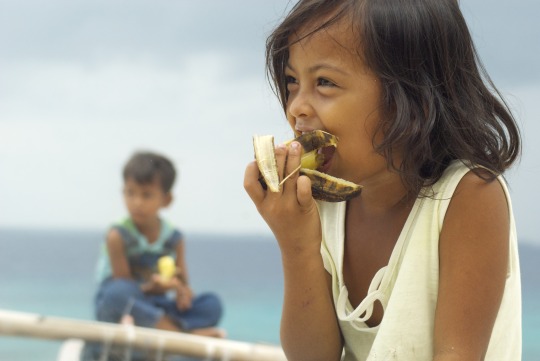Link
Have you seen #CivilWar? Is it Marvel’s best one yet? The #MarvelZombiesPH crew dissects the film.
We’ve upgraded to a video format for this episode. This is our Phase 2 y’all.
Let me know what you think!
First VIDEO Episode!!!
6 notes
·
View notes
Photo

Spent all night drenched sitting inside one of the quadrants at the Papal mass so I can witness the stories of pilgrims who powered through the weather just to see a glimpse of the Pope. Phone was destroyed because of the heavy rains. And I didn't even get to air our story from inside the mass because of reasons beyond our control. But in the end, it's all worth it. Being in the crowd and seeing the reactions of Yolanda survivors to the Pope's homily was such a humbling experience.
"I’d like to tell you something close to my heart. When I saw from Rome that catastrophe I had to be here. And on those very days, I decided to come here I am here to be with you — a little bit late, but I’m here."
The expectation was that Pope Francis will deliver his homily in English. But the only predictable thing with the Pope is his unpredictability. The Pope used his native tongue perhaps so he could speak from the heart. And as he talked to Yolanda survivors, everyone around me began crying. The Pope came to the Philippines for them, and no storm was going to stop him from carrying out his mission. The crowd waited 18 hours for the Pope. But the Pope waited fourteen months to be with the people he once prayed for.
A Yolanda survivor told me that all the wait was worth it. For the first time since the super typhoon, he felt like he wasn't alone in the fight to survive.
The Pope is not a rockstar because he can bring crowds together. It's because he can make each and every single one of them feel like that they are the only ones in the crowd.
28 notes
·
View notes
Photo
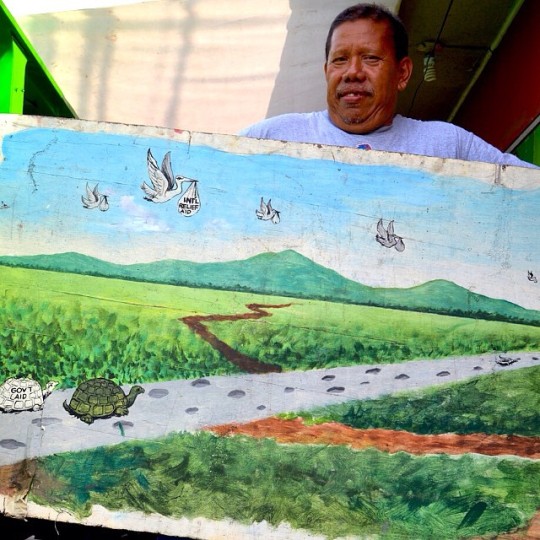
8 months ago, I met Cesar Cayanong while covering the aftermath of Typhoon Yolanda in Tacloban. He was a signboard painter who wanted to inspire his fellow Taclobanons to rise from the tragedy. So using the brushes he retrieved from the rubble, he began painting messages on signboards and posted it outside of his home. “I have no money. I have no food. All I have is inspiration and leftover paint.” Today, I met Cesar again. His frustration with government efforts to rehabilitate his beloved city has led him to paint another piece. He calls this one “Daang Matuwid” — depicting government aid as turtles trudging along a straight and narrow path to Yolanda victims, while a crocodile awaits them in them distance. Foreign efforts meanwhile are depicted as birds hovering above and zooming past the turtles. “I’ve been told help is on the way. I’m not losing hope. I’m still waiting." #haiyan #yolanda #tacloban
22 notes
·
View notes
Text
The one where I spent a month in Malaysia
So what happens when you pluck 18 plucky, young journalists from different developing countries and then fly them off to a foreign land, have them live together, school them about their craft, immerse them with assignments that test both human frailty and hopelessness which in the end will teach them more about each other’s culture, faith, hopes and dreams?
No, you do not get a Disney movie. Instead, you get the Malaysian Press Institute.
Every year, the Malaysian government would invite more than a dozen reporters from various fields — print, TV, radio, multimedia — in a fellowship that is not unlike Tolkien’s group of humans, hobbits, dwarves and elves who take on a singularly-goaled adventure. Except for the part where we have to destroy an evil, all-powerful ring.
For more than a month, the journalists will all live together in a not-too shabby hotel in Kuala Lumpur, and at times, be whisked off in various parts of Malaysia on assignments. They’ll be immersed under the tutelage of the finest journalists the region can offer, amassing new ethical practices and technical skills in the process, while debating about where the industry is heading and where it went wrong in the past. On the side, they get to experience the intricacies of the Malaysian culture.
In the past, they had folks coming in from the Philippines, Sri Lanka, Zimbabwe, Vietnam, Uzbekistan, Indonesia, Bahrain along with the local journalists from various parts of Malaysia.
When I got the call that I was going to be part of it, two things came to mind.
Two rather huge, shiny, impressive things. Adjectives that can also properly describe sexual organs. But no, that’s not what I’m talking about, you dirty, dirty perv.
I’m talking about the Petronas Towers.
I’ve seen it in a couple of movies — all towering and grand-like, stealing scenes even as a backdrop. So the fellowship was a chance to see those towers in person — one off my bucket list, I thought. Which was more than enough for me to say yes to the program.
It was a shameful, shallow reason, yes. But a reason nonetheless.
I didn’t know what would happen in the fellowship or what sort of journalists I’d meet in the process. Did they have the same practice in their respective countries? How do they report on religion and conflict? How restricted are they in covering their respective governments? Is corruption as institutionalised in their industry as it is in ours? How much are they getting paid in their countries for this job? Are there differences in the way they build their newscasts? Is policy over police, or the other way around? Will we get into arguments over what’s ethical and what’s not in their brand of coverage? Am I gonna make friends? Will the program give us free meals? And is it spicy?
A myriad of questions and questionably-sized luggage in tow, I arrived in Kuala Lumpur in the wee hours of August 31.
It was a long way to the apartment-style hotel near the school in Jalan Bukit Ledang, a residential area just outside of the capital city. The driver of the airport taxi I hired kept complaining how difficult it was to get to the area because apparently, if you miss that one junction in the highway that directly leads to the hotel, it’ll take you another 20 minutes just to turn on the next roundabout. He missed the junction twice. On a side: I was given a quick lesson on traffic vernacular in KL — junction and roundabout. I could hear myself thinking: “Back in my hood, we call them exits and circles. Philippines, reprezant!”. Also, I don’t know why that voice in my head sounded ghetto.
My flight must have arrived rather late because when I got to the hotel, there wasn’t anyone there to hold up streamers and hand out pamphlets to welcome me to the program. Instead, I get the receptionist — a woman so tiny she can literally fit in my pocket, who eerily looked like Malaysian action star Michelle Yeoh (now you see how limited my Malaysian knowledge really is) — who handed me a card key. She told me that all the rest of the fellows have been checked in and I was the last one.
She gave me a quick run-down of house rules. No drinking, smoking can be done in the balconies, no losing of key cards, free breakfast is served at six o’ clock. Each room comes fully-equipped with a kitchen, a bathroom and two beds — slightly separated by a glass division to feign privacy.
When I get to my room, one of the beds was already in disarray. There were a couple of bags stowed away in the corner, and a row of polo shirts neatly hanging in the closet. No one was there. But it meant one thing: someone already called dibs on the best bed in the room — one that had a television on the left, and a panoramic view of the city to the right. I get the bed enclosed in a glass panel right next to the bathroom. Awesome.
I dropped my luggage in the corner, and grabbed the small pack of Boy Bawang I hurriedly stashed in the front pocket while I was still at the airport. Because Boy Bawang is how I roll. And I also realised that it was already 2 o’clock in the morning and I’ve yet to eat dinner. I started to unpack when the door opened. First thing that sprung to mind was that it was my new roommate. Or a serial killer. Or both. A roommate who is secretly kills people while they sleep, through asphyxiation, and then turns them into a taxidermic project in his basement where all the other doll victims are displayed for his pleasure. If you’ve had as much roommate horror stories as I’ve had back in college, this is how your mind works.
“Hi, I’m Danny.”
Danny greeted me with a such a welcoming smile — the one where’d you feel like he’s known you for a long time and that this was a reunion and not an awkward introductory chat. He was tall, framed like someone who’d be into sports, with a face of an actor you’d see in a Stephen Chow movie. He told me that he worked for a Chinese newspaper in Kuala Lumpur and that he’s usually assigned stories from the general assignments desk. He too was worried about the program. Like me, he wasn’t sure of what to expect.
But most importantly, he did not exhibit serial killer tendencies.
I slept soundly that night.
I woke up with the buzzing sound of the alarm clock. Danny was already dressed and getting ready for the first day of the fellowship.
“Bangun!”
I was jolted from my stupor. Why is Danny talking in Filipino? How is that possible? Am I still sleeping? Is this still a dream? Or a dream within a dream wherein any minute, Ellen Page and Leonardo DiCaprio will bust open the front door?
“Bangun lah!”
Turns out, the word for “get up” is the same in Tagalog and Malay. This is how Danny would wake me up for the rest of the month.
When we got down to the lobby, all the rest of the fellows were there. You could feel the first-day-of-school-type excitement in the air. Everyone was chatty, introducing themselves United Nations-style: “My name is (insert name) from (country of origin). I’m a reporter for (insert media organisation). Stay away from the chicken sausages!” That sort of thing.
As I sat there, listening to everyone tell their stories, all my apprehensions about the program were gone. We were all in the same boat. All journalists, all young, all slightly damaged from the work that we do. But there’s certain glee shared by everyone — we’re here to learn, and we’re here to be better. It was a comforting feeling of community.
From the hotel, it was a 15-minute walk uphill to the school. It was tough climb, especially for those not used to, well, walking. The environment was very green, one where’d you stop after being startles by monkeys crossing the street or jumping out of trees. While walking, we continued talking about our lives back home. Where I come from, there were no monkeys in the urban areas.
When we got to the school, a small, gated establishment with the letters “MPI” greeted us at the front. There were two buildings — one for the administrative work, and the other, a classroom. There we would meet Maimunah Abdrashi.
“You all can call me Kak Mai. Because I’ll be your mother for the next month.”
Kak Mai was the program director. She wore a veil, slightly covering a beautiful face that wore age and experience well over the years. She evoked a sense of order and discipline, coupled with that heartwarming care only mothers can pull off. Kak Mai told us all about the program — about how we would hold lectures and seminars in that classroom on some days, while on others, we’d travel to others parts of Malaysia to immerse ourselves in the culture and in field work. It was going to be laborious — and she’ll be there every step of the way to make sure that we do it. One way or another.
From there, the rest of the month went by rather fast.
During the weekdays, we would attend seminars from lecturers recruited from various parts of the region to teach us (and remind us) about elevating our writing, tips in interviewing, editing audio and video, best practices in multimedia reporting and harnessing our ethical judgment. We’d often get into heated arguments about our industry’s best practices — that’s what you get with 18 different perspectives and worldviews. We’d always end up agreeing to disagree.
We visited Putrajaya to learn more about Malaysian politics and policies. We visited the TV3 studios where we got a glimpse of how TV news operates in the country.
During weeknights, the local fellows would bring us foreigners around Kuala Lumpur — in the best restaurants, in night-time tours of old, colonial structure, in temples both Buddhist and Hindu, in the most delicately-constructured and intricately-designed mosques — to learn more about the melting pot that is their city.
We were whisked off to Langkawi on a multimedia reporting assignment — where we got to spend time at the beach to do our stories. Sleepless nights also ran abound as we helped each other create and edit our projects. We were brought to the historical city of Malacca — where we bargained in the haphazard markets during the day and then sang our hearts out in dingy videoke establishments at night.
Weekends, we’d travel to the usual tourists locations — yes, Petronas Towers included.
The best stories are all always about people. And this one is no different.
The MPI was filled with friends and fellows that I’d never forget.
There’s roommate Danny, who was always sleepy in class but would wake everyone up with wittiest zingers and punchlines. There’s Arashy, a TV reporter from Kuala Lumpur, who would teach me how to speak Malay while we’d edit through heaps of material for video presentations. When there’s a prank abound, it’s usually the handiwork of Arashy. There’s Lloyd, a political journalist from Zimbabwe, who taught us a lot about life in Africa beyond his newsroom. There’s Eri, a radio reporter from Sarawak, who was the best person to talk to about anything under the sun and over bottles of beer. There’s Vi from Vietnam, who was has the best taste in food — primarily because we both steer clear from the spicy dishes. We also share a deep regret over concerts we might have missed while in KL. There’s Prema, the group’s big sister —strong-willed and kind-hearted — who can’t ice skate to save her life. There’s Zetty, a veteran crime reporter based in Kuala Lumpur, who would take time off just to make sure that the international fellows would have great time touring the city. There’s Didi and Farol who would often fill the room with such joy and laughter.
Today, we’re all still in contact — keeping tabs on work and in life. It’s proof that you bring together different people from different counties and you could still have world peace.
I write this now because I just recently found out that we would be the last batch of the MPI international fellowship. Which is a shame, really.
More than anything, the MPI was that rare opportunity wherein young journalists on the verge of an angst-ridden career are given a much-needed pause. A moment to reflect on what they’ve done, and decide on what they plan to do after as pursuers of truth. It’s a welcome respite in an industry filled with unrealistic deadlines and extraordinary stress, where one goes from one assignment to another to a point where it all blurs together.
When I think of Malaysia now, two things still come to mind.
It’s not the Petronas Towers anymore. But it’s as complex, beautiful and strong: the MPI and the great memories that go with it.
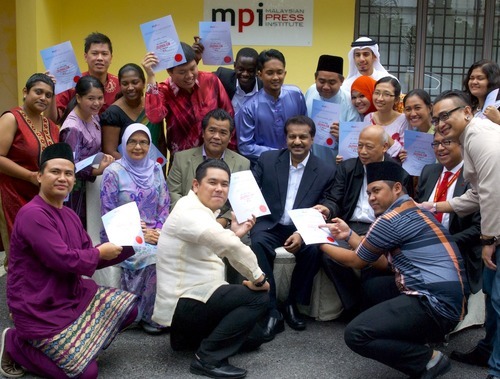
16 notes
·
View notes
Photo

Meet Maji who owns this little shop of trinkets in a souq in #sharjah. Charming how organically cluttered this small hole-in-the-wall is. In my mind, he's Rupert Giles and he owns this magic shop. #travelhits
6 notes
·
View notes
Text
Talks
Getting invited to talk to students is always a fun thing. Except for the hours that precede it when you’re cramming in preparation, college-style, replete with cups of watered-down cappuccino and empty power point slides. It’s a frustrating thing, really. Not because you don’t want to do it and delay the inevitable. But preparing for these sorts of things forces you to finally pause from the seemingly endless chain of stories, take a break from the daily grind of reporting, and actually look back and find meaning in seemingly meaningless moments in your career.
You’d want to believe that shooting it from the hip will ultimately save you from the utter embarrassment of saying nothing in from of hundreds of empty faces, staring at you for being an ass. But improv-ing a talk is kinda like a salesman selling you a wondrous new product — BS-ing your way though it but having the customer ultimately shutting the door in your face because they didn’t buy what you were saying.
I’m giving a big talk this week. And I don't like doors getting shut in my face.
Which is why I’ve decided to lock myself in a room. Stare at the last eight years of my career in the face. And reflect.
But the real point of this writing is that I’m just procrastinating.
Because eight years worth of reportorial baggage can be a bit daunting.
Wish me luck kids.
14 notes
·
View notes
Photo


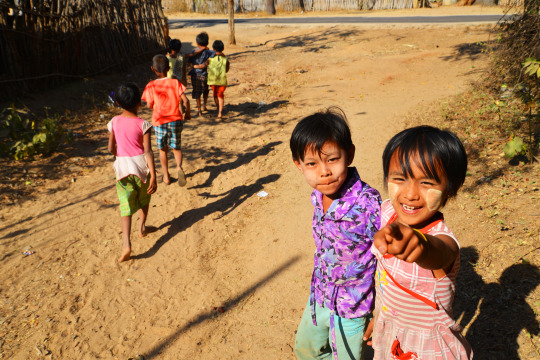
The cool kids from Bagan.
Stopped by this village en route from Mount Popa back to old Bagan. Met the most welcoming of kids, all of them wearing thanaka on their faces -- this yellowish-white ground bark-turned-facial mask which is a popular cosmetic paste in Burma. Such an awesome sight to see old traditions still being practiced.
22 notes
·
View notes
Photo
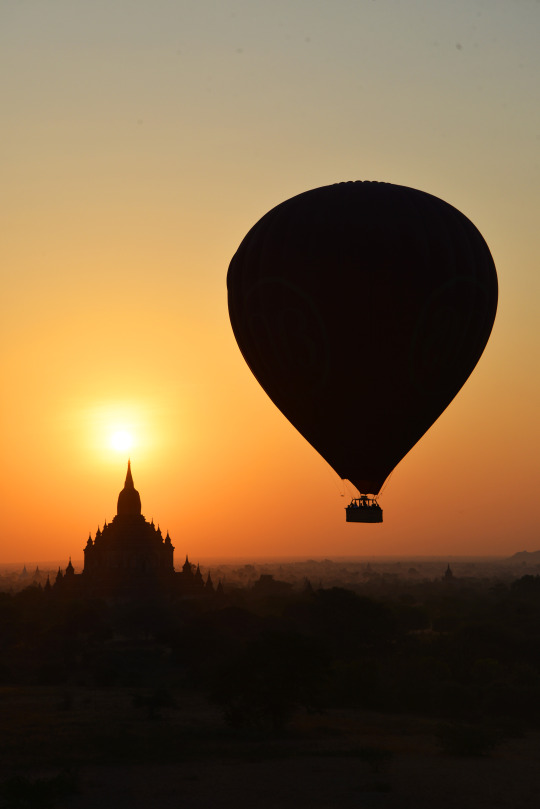

Burma is a moment in time.
Every hour, you'll find yourself in a corner where magic seemingly awaits curious tourists. Every second feels like you're walking back in time, into a world that was hidden but never lost.
It was a long journey to get to this place. But damn, it was all worth it. Sharing with you some photos from a recent trip to Yangon and Bagan. If this is the first of (hopefully) many travels this year, well, Burma set the bar rather high.
Will write more when I get a moment in time.
90 notes
·
View notes
Video
Salamat.
youtube
#PHthankyou | The Philippines says Thank You!
(By the Philippine Department of Tourism)
41 notes
·
View notes
Video
vimeo
Shot, produced and edited this story with my cameraman, Romel Zarate, for this year's coverage of the Feast of the Black Nazarene.
In the last seven years, we've always been on the sidelines of the annual procession -- the biggest in the Philippines -- reporting on the millions of devotees who try to touch the image of the Nazarene which they believe is miraculous. Some devotees also describe it as penance, considering that performing such task could be quite dangerous. They call it "panata" - a religious pledge.
This year, we wanted to document what devotees of the image go through just to climb the carriage that carries the image and why it's important for them to fulfil their promise. We wanted to bring the audience at the centre of the chaotic scene and show them up close what happens around the carriage.
The story aired on TV Patrol and ANC. This online piece for ABS-CBN News Online, titled "Panata", chronicles our day of coverage when we joined a group of devotees in their mission to climb the carriage. The piece shows you some behind-the-scenes footage of what happened before, during and after.
Shot using Nikon D600, GoPro Hero 3+ and GoPro Hero2.
7 notes
·
View notes
Text
The Macaulay Culkin Syndrome
Wrote this two years ago when I spent Christmas in Iligan City to cover the aftermath of Sendong. Until now, the memories remain.
_____
I have, as my friends call it, the Macaulay Culkin syndrome.
Every Christmas, I dream of not being home alone.
Since returning to the Philippines eight years ago, my December calendar is usually filled with four words – work, work and more work. It’s a way of coping. For years, I’ve stood by this rationalization that if I keep myself busy, I won’t have a second to feel the loneliness of not having a family to spend Christmas with.
My family lives in the United States. Rarely do they get to visit the country during the holiday season. So our Christmases are usually spent on the phone – greeting each other and trying our hardest to feign merriment just to hide the worry and guilt of being together at a time when families should. That’s the life of an OFW family. Well, in this case, I’d like to think more of myself as the OFW.
But this Christmas was to be different.
Remember that moment when Kevin McCallister, Macaulay Culkin’s character in the movie, wakes up on Christmas day to find his family there waiting for him after being left home alone? Well, I was to have that Macaulay Culkin moment. That one Christmas when you wake up and your dream is right there.
My family made plans to fly out to Manila to spend Christmas here. For the first time in years, I wasn’t going to be home alone. I took a leave from work. I made sure that the few days that they’ll be spending here will more than make up for all the Christmases we weren’t able spend together. With all the vindictiveness I could muster, I was going to put the past Christmases to shame.
But as they say, even the best-laid plans go wrong. They hit a travel snag and couldn’t fly out ‘till Christmas Eve. Which was fine. Delaying gratification gives things more worth, more weight.
But then Tropical Storm Sendong hit. December 18, I found myself being shipped to Iligan City to cover the aftermath of the year’s deadliest storm. Since I wasn’t sure when I’ll be flying back to Manila, my family decided to stay in the US and delay their trip for a few more weeks.
So at a time when I thought I’d be hanging Christmas decorations in our home, I found myself walking through rows of houses destroyed by the storm, visiting empty homes that reek of the smell of mud and death. Instead of attending parties, I was in funeral homes – counting cadavers upon cadavers. At at time when I thought I could have a whiff of Christmas, I was wearing a face mask to protect myself from the stench of decaying bodies. I wasn’t with family or friends. I was with strangers in evacuation centers. I wasn’t listening to Christmas songs. I was hearing stories, painful ones, of victims who lost their loved ones during the massive flood that followed the storm.
A few days ago, I was walking around Barangay Hinaplanon – one of the hardest-hit areas in Iligan. Not really going anywhere but just going somewhere. Out of the corner of my eye, there was a boy covered in mud. He was digging with his father. They were looking for their Christmas tree which they lost during the flood. Behind them was a throng of neighbors, picking up whatever they could find valuable in a mountain of rubble.
The boy’s name is JK. And at a time when smiles were a rarity in Iligan, he greeted me with one. I approached him and asked him what he was doing. He told me that he wanted to dig up their tree so that they could still have Christmas. His family planned on spending it together and he has been looking forward to it all year. He thought that without the tree, his family couldn’t have it anymore.
It’s strange how victims of calamities have so little to give but so much to offer. There I was, thinking of the what-ifs of Christmas and JK showed me what is. I looked at JK and I saw myself – a kid wanting to have that Christmas. That amid the devastation, confusion and the pain, JK underscored what’s important during Christmas – family.
I shared JK’s story that night in living rooms across the country through TV Patrol. Upon hearing his story, a kind-hearted Iliganon messaged me and arranged for money to be wired so that Sagip Kapamilya can buy a Christmas tree for JK. The very next day, JK’s wish was granted. Under their new tree, his family gathered and had their Noche Buena.
It’s far from what they had before. But it was more than enough for them.
In the darkest of times, JK had his moment. He woke up to a Christmas worth celebrating. He was Macaulay Culkin.
Of course, their problems are far from over. But at least for one day, one moment, there was hope. Hope that people will continue to believe even when tragedy strikes. Hope in strangers sharing what they have.
It’s Christmas today. I’ve received countless messages and phone calls from friends, family and colleagues asking how I was here in Iligan. Most of them in disbelief, others sympathetic, that I spent Christmas here.
Strangely, I’m alone but I feel right at home.
It’s not the Christmas I imagined but it’s the Christmas I needed. If anything, JK’s story reminded me that even when things get rough, we can still make that Macaulay Culkin moment.
15 notes
·
View notes
Text
A few days, maybe more.
47 days after and I’m back in Manila. Sipping a warm cup of comforting, overpriced, Christmas-themed coffee in an uppity shop where college students feign interest in stacks of readings, and journalists pretend to write. It’s a far different world from where I was in the last couple of months.
47 days covering a flooding in Zambales, an earthquake in Cebu and Bohol, and a super-sized typhoon of epic proportions in Tacloban. Hyperbolic statements can’t even begin to describe that last one.
But to better understand these 47 days, I’d have to do so using disaster-related units. I left Manila before Typhoon Santi hit. I came back way after Typhoon Zoraida left the country’s area of responsibility. In the alphabetized world of local weather-forecasting, 47 days is a lot of letters.
During those 47 days, my cameraman would often ask me when we’d return to Manila. And I’d nonchalantly answer him with the most noncommittal of replies: In a few days, maybe more.
When I got back to Manila, I wanted to write about stories from Tacloban that never made to air – stories about people that would hopefully inspire and engage others into action. But since I got back, I’m either mildly despising or just get virulently put off by every word I write.
I’d always tell myself that perhaps there’s a need to rest a bit, and take the writing in stride. In a few days, it’ll come. Maybe more.
But what else is there to say really that hasn’t been said by other writers, photographers and videographers trying to make sense of what happened in Tacloban? Much has been said. And I’d like to think that at the end of the day, no amount of justice can be done to the stories there. No verbose articles, no gut-punching documentaries, no heart-wrenching photograph, no bullet-points, no Venn diagrams, not even kindergarten stick figures. Nothing can properly explain or illustrate how much Yolanda has changed the lives of everyone caught in its path.
Yolanda.
Weird how it took so long before I mentioned that name here. A name that you can’t say without bringing up the pain and destruction it caused in the same breath.
Over the last few days, I tried writing about that. About houses demolished to pieces by a raging storm surge. About tragedy not having any visible demarcation. About the dead bodies scattered in the streets of the city, waiting in vain to be remembered by those who loved them or even by those who knew them. Bodies waiting to be recovered and be given a proper ceremony for a life that was lived and abrasively cut short. About people who survived but were left to fight for that second life because of hunger, thirst – and the worst of all – sorrow.
But I couldn’t. I’d always end up Ctrl-Z-ing every pathos-filled phrase and punctuation.
I was looking at photos I took from Tacloban during that time to get some inspiration, maybe even a sense of sanity. And then I stumbled upon a series of photos that made much more sense to me than the images of tragedy. Photos that depicted hope.

Meet Cesar Cayanon.
A signboard painter since he was 15, Cesar told me that he lost everything in the storm – save for his life, a few cans of paint and a lot of inspiration. The day after the storm, he found some brushes from the debris. And so he painted.
“Hindi ako naniniwalang walang pag-asa. Nandito ang mga Leytenyo.”
Cesar hopes that with his signs, he can inspire others to stay in Tacloban and fight. He says it doesn’t matter if they win or lose in the end. The point is that they fight.

Meet Locela Domingo.
She lost her home from Yolanda. She sent her children to Manila to seek refuge among relatives while she stayed behind. She now lives in a makeshift tent in a sidewalk near the Capitol building.
She told me that she’s always thinking about her children especially now that Christmas is nearing. She’d describe the holiday as her favorite. Her family would be gather around the dinner table, and what little they had, they still found something to celebrate and be thankful for.
This year, Christmas will be different for Locela. With her children away from her, she decided to pitch a tree she found in front of her new home. Instead of the usual star, she placed the flag on top of it.
With what little she has now, she says there are still reasons to be thankful for.
“’Yung Christmas tree para hindi tayo mawalan ng pag-asa, yung bandera, para ipakitang may tiwala pa rin tayo sa bansa natin.”
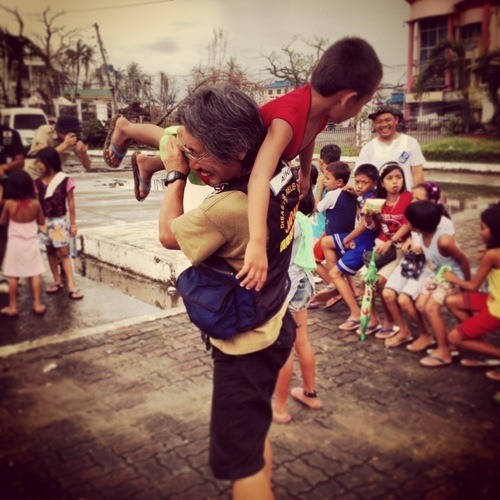
And finally, meet Aoki and the rest of the Japanese volunteers.
It’s payback, they say. Filipinos helped them out during the devastating quake and tsunami in 2011. And it’s only fitting, they say, to be in Tacloban. Like tragedy, kindness has no borders.
The Japanese team’s primary job was to set-up a medical tent to offer aide to the victims. But every morning, the volunteers would find themselves some free time. And they would spend it with the children who were living in a nearby tent.
They couldn’t understand what the children were telling them about Yolanda. And the children couldn’t even begin to fathom what the Japanese were saying. But in Tacloban, language wasn’t a barrier. People understood what it meant to be there for each other.
Rumiko Nomura, a Japanese volunteer, said they enjoyed playing with the children every single day.
“I love to see their smile because even if there’s a huge disaster, you can still see them smile.”
Stories like Cesar’s, Locela’s and Aoki’s are in abundance in Yolanda-hit Tacloban. You’d see the best in people in the worst of circumstances.
You’d hear them and meet them, and suddenly, you find yourself believing that like everything else, this too shall pass.
Hope has a contagious quality. It reaches your black-forlorn heart, sticks to you and infiltrates your being in the most unexpected of ways.
Tacloban and the rest of the places that were hit by the typhoon has a long way before it recovers. Donations are still needed – from food and water to clothes and shelter. Vigilance is needed to make sure that the government does its job of rehabilitating these typhoon-struck areas and that they serve the people and not other interests. People who are still looking for the missing need a more systemized way of finding loved ones, to give the dead the proper ceremonies and the living, the proper closure. Creating jobs, fixing schools and hospitals, bringing back power – the list is endless.
It’s going to be a long time before anyone can say that everything will be okay. Certainly not tomorrow.
But with hope slowly creeping in, who knows?
In a few days, months, years. Maybe more.
Not today. But it’ll come.
57 notes
·
View notes
Photo
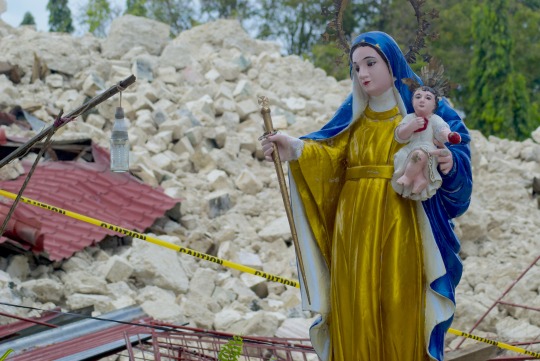
Patroness. 10. 22. 13. Loon, Bohol.
The recovered church relic now stands amid the rubble of the church that once housed it.
12 notes
·
View notes
Photo

Relics. 10.22.13. Loon, Bohol.
Faith heals. And it's apparent in the town of Loon where the centuries-old Church of Our Lady of Light once stood.
The structure collapsed after last Tuesday's 7.2 magnitude earthquake that hit Central Visayas.
Beneath the rubble, rescue teams found the statue of Our Lady of Light in one piece.
For devotees, the recovery of the church relic was "miraculous". They describe it as "symbol of hope".
For non-believers, no words can explain why devotees find comfort in a statue. For believers, no words are needed to explain how a relic is helping them believe that hope springs eternal.
17 notes
·
View notes
Photo

Cornelia. 10.22.13. Loon, Bohol.
A week after the massive quake that hit Bohol, she's still recuperating inside a makeshift tent outside the town's hospital.
Lola Cornelia was injured after a wall fell on her during the quake. Neighbors say it took several hours before she was pulled out of the rubble.
At 78 years old, she's definitely a fighter.
11 notes
·
View notes

